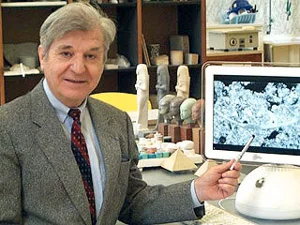
Жозеф Давидовиц
Жозеф Давидовиц (фр. Joseph Davidovits, родился 23 марта 1935) — французский химик, материаловед. • Автор более 130 научных статей и докладов конференций, более 50 патентов. Изобретатель монолитного строительного материала, названного им «геополимер», образующегося при взаимодействии в щелочной среде компонентов, в основном геологического происхождения, содержащих алюминаты и силикаты. Награждён орденом Заслуг Франции. Автор теории, согласно которой Египетские пирамиды построены из аналогичного геополимерного бетона. В России Давидовица поддерживают авторы «Новой хронологии». Теория признана научным сообществом как противоречащая результатам многочисленных исследований известняка пирамид и соседних каменоломен. В 2007 году петрограф Дипаян Джана (англ. Dipayan Jana), в своей презентации для ICMA (International Cement Microscopy Association), а затем и в статье показал, что известняк, из которого построены Великие пирамиды, вопреки утверждениям Давидовица не содержит щелочных алюмосиликатов, определяющих геополимерный бетон, и заключил, что «мы далеки от того, чтобы принять даже в качестве отдалённой гипотезы возможность рукотворного происхождения камней пирамид». • Joseph Davidovits (born 23 March 1935) is a French materials scientist known for the invention of geopolymer chemistry. He posited that the blocks of the Great Pyramid are not carved stone but mostly a form of limestone concrete or man-made stone. He holds the Ordre National du Mérite. Davidovits asserts that the ancient Egyptians did not possess the tools or technology to carve and haul the huge (2.5 to 15 ton) limestone blocks that made up the Great Pyramid, conjecturing instead that the blocks were molded in-place by using a form of limestone concrete. According to his theory, a soft limestone with a high kaolinite content was quarried in the wadi on the south of the Giza plateau. It was then dissolved in large, Nile-fed pools until it became a watery slurry. Lime (found in the ash of ancient cooking fires) and natron (also used by Egyptians in mummification) was mixed in. The pools were then left to evaporate, leaving behind a moist, clay-like mixture. This wet "concrete" would be carried to the construction site where it would be packed into reusable wooden molds. In the next few days the mixture would undergo a chemical hydration reaction similar to the setting of cement. Davidovits' theory is inconsistent with the geological evidence.